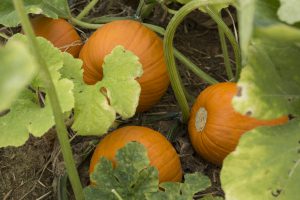Few things are more iconic for fall than the pumpkin. You can smell it in the air (with fall-scented candles), drink or eat it in the morning (pumpkin spice lattes and muffins), and decorate your house with Jack-o-Lanterns and small ornamental pumpkins. Over the last few decades, pumpkins’ popularity has risen as new cultivars have made it to our stores.
What makes a pumpkin a pumpkin

A few years ago, if you asked what a pumpkin is, most people would describe it as a hard vegetable that people use for carving jack-o-lanterns for Halloween or delicious pies. However, in truth, it is more difficult to describe. Pumpkins are members of the Cucurbitaceae or the gourd family. More well-known members of this family include cucumbers, watermelons, non-edible gourds, and squash. Pumpkins are a member of the squash group. They are often described as having a rounded, ribbed shape, a thick outer skin, and a hollow interior. Having an orange exterior and yellow interior was also a key identifying feature. We now have pumpkins in many colors (including white), textures, and tastes.
Pumpkin uses
If left uncut and stored in a cool, dry place, pumpkins have a reasonably long shelf life. All parts of the pumpkin are edible, including the vine itself. While all pumpkins are edible, not all are tasty; many should be used for decoration only. The giant pumpkins are best used for decorations and carving. They can be cooked (if they haven’t been carved), but the flavor is usually bland and stringy. You may see more petite sugar or pie pumpkins in the grocery section. These are great for cooking and can be used in dishes like soups, stews, desserts, bread, gnocchi, and even in drinks. Make sure you allow the pulp to drain if you use them for a pie. Pumpkins are high in potassium, magnesium, and a multitude of vitamins.
Growing pumpkins

Pumpkins need three and a half to four months to mature and should be planted no later than July. If planted too early, plants experience viral and fungal diseases. Most pumpkins need at least 6 feet to spread out except for bush pumpkins. Choose a variety of pumpkins to meet your needs. ‘Howden,’ ‘Jackpot,’ ‘Big Max’, and ‘Big Moon’ are some suggestions for a Florida Garden. ‘Spirit’ is a semi-bush and a good multi-use pumpkin. For cooking, grow ‘Jarrahdal,’ ‘Long Island Cheese,’ and ‘North Georgia Candy Roaster.’
The last suggested pumpkin is called the Seminole pumpkin. This is “one of the tastiest and most reliable pumpkins for Florida gardens.” As the name suggests, the Seminole tribes often planted this pumpkin and would slice and dry the fruit. This pumpkin is one of the few vegetables that can withstand the summer heat.
Unfortunately, the growing season for planting pumpkins in Florida has already passed. However, you can grow pumpkins in two different timeframes in our area. It is best to plant pumpkins either from January – April or August-September. Remember, if you have them growing through the cold months, you may need to protect them from freezes.
Celebrate National Pumpkin Day in your favorite way, whether it be in a pumpkin spice latte, a pumpkin muffin, or, my favorite, in a pie!
For More information:
PUMPKIN—CUCURBITA SPP.
Calabaza — Cucurbita moschata
Seminole Pumpkin
DIY Seminole Pumpkin Pie and Puree
 1
1
